 1
1 VI. SIMPLE REGRESSION
A. CRITERIA OF FITTING A LINE
Suppose that we have observed some data on income and tea consumption

We wish to fit a straight line to this data. Clearly, it cannot pass through all the points. This leaves us with the problem of how to fit the line.
The equation for the line will be
whereis the point on the line that
corresponds to a given x, contingent on our choice of a and b.
Let
be the difference between the fitted value and the observed value of the dependent variable.
a. One possible criteria for the selection of a best line is that line which makes the sum of the ei as close to zero as possible
This has one obvious drawback

There are a large number of choices of a and b that will make Q/5 zero.
b. One way to cure this problem is to use
Analytically, this is very difficult and really is a problem in linear programming.
c. A final consideration is the sum of squared errors, i.e.
This puts very heavy emphasis on large errors, ei and is analytically tractable.
However, before solving for estimates of the a and b we shall present a more
formal statement of the problem.
B. MATHEMATICAL MODEL
We can show the relationship between tea consumption and income as a conditional
probability density .
The problem is that we are not capable of observing a deterministic relationship between Y and X.
Reasons:
1. relationship is inherently stochastic
2. we observe X and Y only imperfectly
3. there is more to Y consumption than income X.
Instead, the situation appears as in the following diagram. For a given value of
the independent variable there are many possible realizations of the dependent variable.
When we collect sample data we observe only one possible such realization for a given
value of the right hand side variable. The figure shows the expected value of Y
conditional on X as the heavy line in the X,Y plane.

Generally, we often focus our attention onthe population regression function where
A convenient assumption is that the population regression function is linear in X.
The population regression is denoted
where u is the unobservable, true disturbance.
From the sample we find
are our estimates of a and b.
is the observed error
.
Before considering procedures for constructing estimators let us consider two
properties of the population regression function.
PROPERTY 1
Proof:
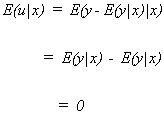
This property suggests that deviations from the population regression function
have a mean of zero, given X.
PROPERTY 2
Proof:
Now 
since
This property implies that the disturbance is uncorrelated with the independent
variable.
Some assumptions:
1. a.
or
b. 
2.
3. The X are constants in repeated samples of size n.
PROCEDURES FOR ESTIMATION
1. Analogy
We have the sample regression function
We wish the following to be true
1.
2.
These two items are the sample properties analogous to the two for the population that we just discussed. The first one says that on average the residuals should be zero. The second one says that the residuals should be orthogonal to the independent variable.
These two conditions can be written, upon substitution as
1.
2.
Carry the summation signs through
1.
2.
These can be further simplified
1.
We now have two equations in two unknowns which can be solved to give
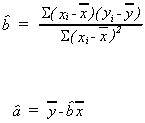
2. MINIMIZE THE SUM OF SQUARED ERRORS
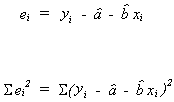
We can differentiate with respect toand
get the first order conditions for a minimum. The two equations can then be solved for the
appropriate
and
.
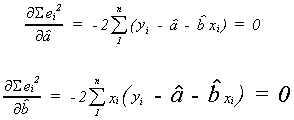
We recognize these two equations as the same as those in the previous procedure, so we
are done.
3. MAXIMUM LIKELIHOOD
Consider a sample of independent and identically distributed r.v.'s, ui,
all having the density function. We can
write the likelihood function as
Recall that we can state the principle of maximum likelihood estimation as:
Choose the estimator,, which maximizes
the likelihood that the sample was generated by a probability distribution of the assumed
type.
Assume then
and
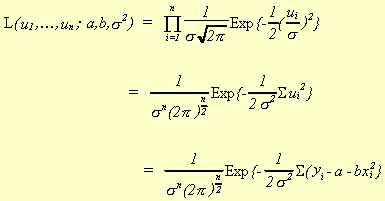
Maximizing L is accomplished by minimizing the exponent. Taking logs will simplify this task.
Now,
(1)
(2)
(3)
(1) and (2) are the "normal equations" that we have seen twice before.
We can solve (3) for an estimator of
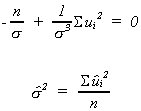
We have constructed maximum likelihood estimators of a, b andunder the assumption that the errors are normally distributed. Note
that the denominator of the error variance estimator is scaled by n, not n-1.
Theshould be considered functions;
rules for converting sample information into guesses about the population parameters. The
rule is a random variable, until we plug in some sample information.
PROPERTIES OF OUR ESTIMATORS
1. EXPECTED VALUE

We will investigatefirst.
Define
We should note two things about
1.
2.
proof:
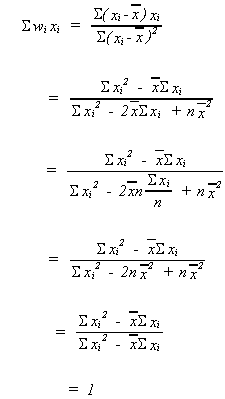
Using our definition of wi
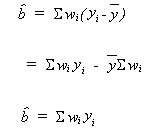
but
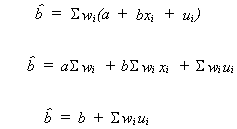
because of the two properties of wi noted above

recall Eui = 0
is unbiased
Now consider
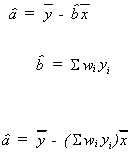
rearranging
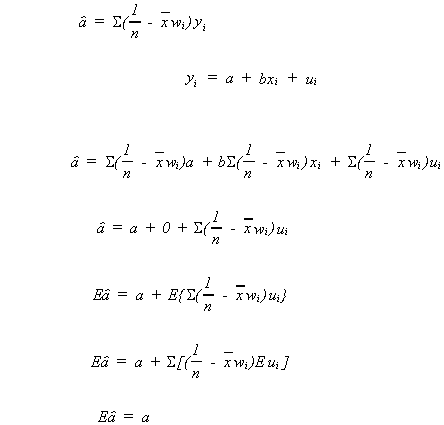
We will defer consideration of the bias of estimators foruntil a later date.
2. VARIANCES
Again we will considerfirst. By
definition
Recall
so
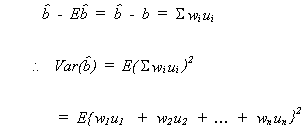
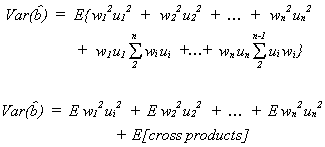
recall our assumptions

So
recall
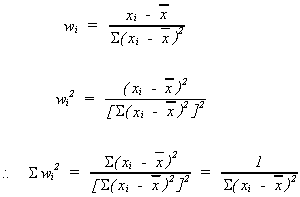
Finally,
From this expression for the variance of the estimator, we can see that our estimator is more precise, the greater the dispersion of the independent variable.
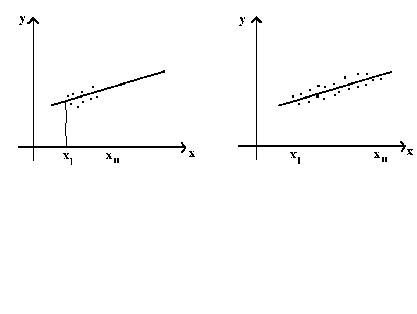
In the left panel we observe y for only a small range of x so there is some doubt as
to the relationship between x and y as x becomes large. This doubt is measured by the
variance of. Alternatively, if you must
balance a beam on top of two points, are you more confident in the beam remaining balanced
if the two points are close together or far apart?
The variance ofis easily found
recall
with the expectation all the cross products drop out so our concern is with
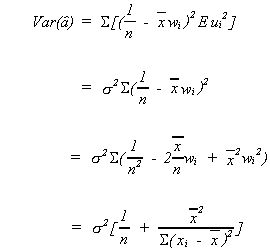
3. BEST LINEAR UNBIASED ESTIMATORS (BLUE)
Within the class of linear unbiased estimators ofand
there should be one that has
the smallest variance.
By linear we mean the estimator is to be linear in Y. Unbiasedness is clear. By
"best" we mean the estimator has the smallest variance of any estimators.
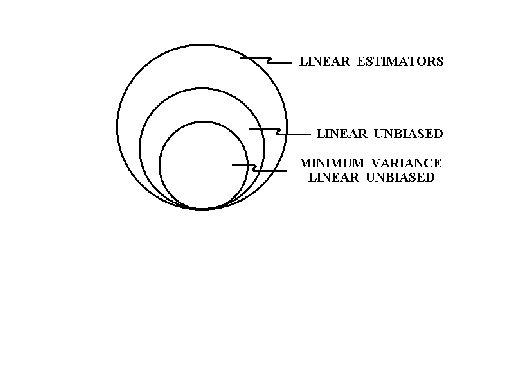
We have derived the OLS estimator and demonstrated that it is unbiased. But, in the class of linear unbiased estimators does it have minimum variance?
Let us construct an arbitrary linear estimate of b.
recall

In order for b* to be unbiased the following must be true

We impose these restrictions so
The variance for b* is
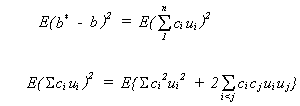
Taking expectations
so
So we wish to
s.t.

Set up the Lagrange expression
To find the constrained minimum we set the first order condition to zero
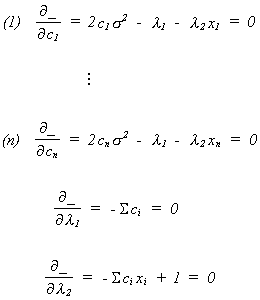
Solve (1) through (n) for the ci
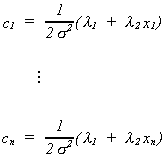
Recall, that is, observe the (n + 1)th
equation. So
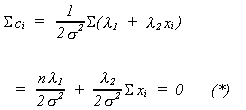
Now multiply each of the ci by xi and add them up to obtain the (n + 2)th equation
Solving (*) and (**) forand
we get
from (*)
substitute into (**)
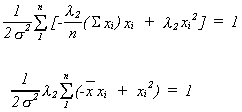
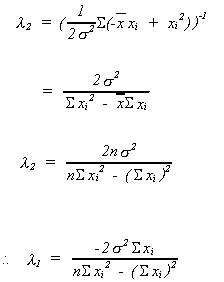
Substituting back into the first order conditions we get
OLS for b is BLUE.
CONSISTENCY
Recall
If
then the sequence of estimators is said to be consistent.
Our estimator is
with variance
since
recall
By Chebyshev's inequality
as, the denominator of the R.H.S. also
therefore

AN UNBIASED ESTIMATOR FOR THE ERROR VARIANCE,
Recall
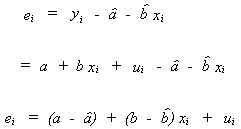
knowingand
from above we can write
Note that the second and third terms represent two linear restrictions.
Let
it is our job to choose k so thatis
unbiased.
Taking a closer look at the numerator. We cam rearrangeto get
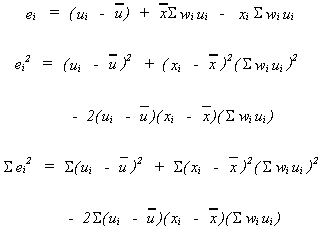
Now take expectations

Note 1:
Note 2:
Note 3:
Therefore

and
is an unbiased estimator for.
Note the following:
1. k = 2 corresponds to the number of linear restrictions on the ui.
2. k = 2 corresponds to the number of parameters we have estimated in constructing the
ei.
3.
VI. F. HYPOTHESIS TESTING
Recollections
1.
2.
3. Ifand
then

Consequently,

define
and not that thein denominator and
numerator cancel to get

EXAMPLE
Let y = GPA score
x = GRE score
Some date has been collected on these two variables. We wish to estimate the
relationships
y = a + bx + ui
n = 8
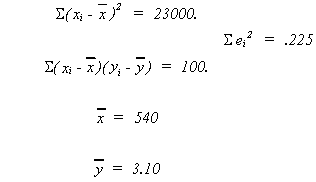
From the data
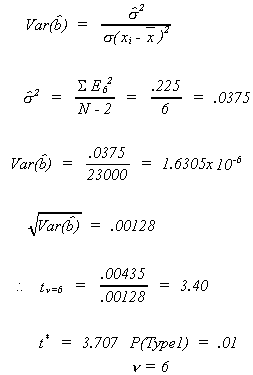
Therefore, we cannot reject the null hypothesis. Note that I chose critical value for
a two-tail test.
REGRESSION WITH TWO INDEPENDENT VARIABLES
Specify the PRF as
or
Subscript of 1: variable number of dependent variable.
Subscript of 2: denotes variable x2
Subscript of 3: denotes variable x3
Subscripts to left of decimal are primary subscripts. The first is the dependent
variable, the second indicates the variable to which theis attached.
The secondary subscript is to the right of the decimal indicates the other variables
present in the model.
ASSUMPTIONS
1.
2.
3.
4.
5. There is not a setand
such that
for all i simultaneously.
INTERPRETATION
intercept
is change in y for a 1 unit change in
x2, holding x3 constant
is change in y for a 1 unit change in
x3 holding x2 constant
OLS estimators:
Again we wish to minimize the residual sum of squares (RSS)
Using the appropriate calculus we get the normal equations
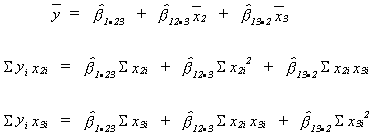
The intercept is obvious.
The three equations can be solved to yield the other two unknowns.
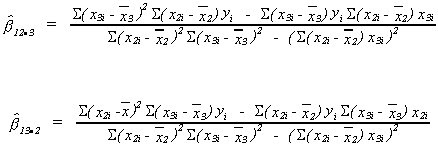
VARIANCES FOR SLOPE ESTIMATORS
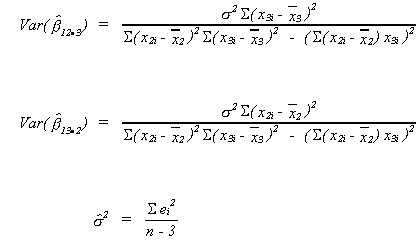
since we have used the n observations to calculate 3 parameters in constructing the
numerator.
Note the following
1. since
2.
since in the simple case
COEFFICIENT OF DETERMINATION, OR THE GOODNESS OF FIT
R2 shows the proportion of variation in the dependent variable that is
explained by the independent variables.
We note the following
and define
or

AN EXAMPLE OF THE COEFFICIENT OF DETRMINATION AND THE COBB-DOUGLAS PRODUCTION FUNCTION
or
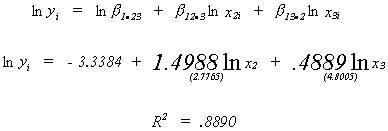
so ~ 89% of variation inis explained by
our model.
COMPARING R2 VALUES
Recall
Nowis a constant. As we throw in more
variables, even if they are really garbage,
will
decline and so R2 will go up.
It seems that we should correct R2 to account for the indiscriminate
addition of variables, i.e., a penalty. So
or
for the example
Constructing a model on the basis of a highis bad procedure. We should be concerned with logical and theoretical
relevance of variables. Beyond that we should consider correct signs and significance of
the estimates.
PARTIAL CORRELATION
Sometimes our interest may go beyond the simple goodness of fit measure. We may be
interested in knowing the explanatory power of the jth variable once we have included the
other j-1 variables. We begin with the simple correlation coefficient, which is closely
related to the OLS slope coefficient in the simple regression model (can you derive the
relationship?). Then we consider partial correlation.
Define the simple correlation coefficient as

we could calculate this for all pairs of variables in the model
1. -1 < r < 1
2. measure of linear association
3. does not imply cause and effect
Also, if there is more than one independent variable it does not reflect the true
association between say x2 and y.
That is, we would like to know the degree of linear association between x2
and y controlling for x3.
Define the following

so
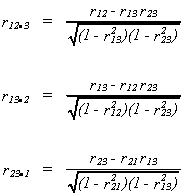
called first order correlation coefficients.
INTERPRETATION
1.
2. and
need not have same sign
3. may be interpreted as the proportion
of y variation not explained by x3.
HYPOTHESIS TESTING WITH TWO INDEPENDENT VARIABLES

our observed t is
which for 12 df is in the critical region for= .05 and a two tailed test.
CONFIDENCE INTERVAL
Let's build a 95% confidence interval for

Note that zero does not lie in this interval. So, at the .05100% significance level we can reject the hypothesis that
is zero.
FISHER'S F-TEST
We may wish to know if bothand
are linearly related to Y. That is, we want to
know if both
and
are simultaneously zero.
Note that if

It is not necessarily true that the intersection of these two events has probability.
We wish to test at the

Doing a t-test on each will not produce the desired significance level.
Define the following terms

We can set up the following ANOVA table
|
||
|
||
|
We can show that when the null hypothesis is true
For the PCE example we have
ESS = 65,967.1
RSS = 77.1690
so
which for any reasonable level of significance lies in the rejection region.
The incremental contribution of additional variables may also be determined using
ANOVA.
As an example we continue with the PCE model.
Suppose we first regress PCE on Income for the model
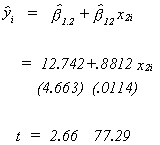
Using a t-test we can seehas a
significant impact on y.
We could also do the test using ANOVA
So again, the model is significant.
Now let us add the time trend and see if it adds significantly to the explanation of
y.
In order to do this we construct a new ANOVA table
To assess the contribution ofafter
allowing for
we form the F statistic
for our example
which is significant.
The advantage to ANOVA is that we can do sets of variables while controlling for sets
already included.